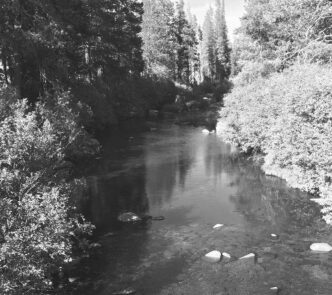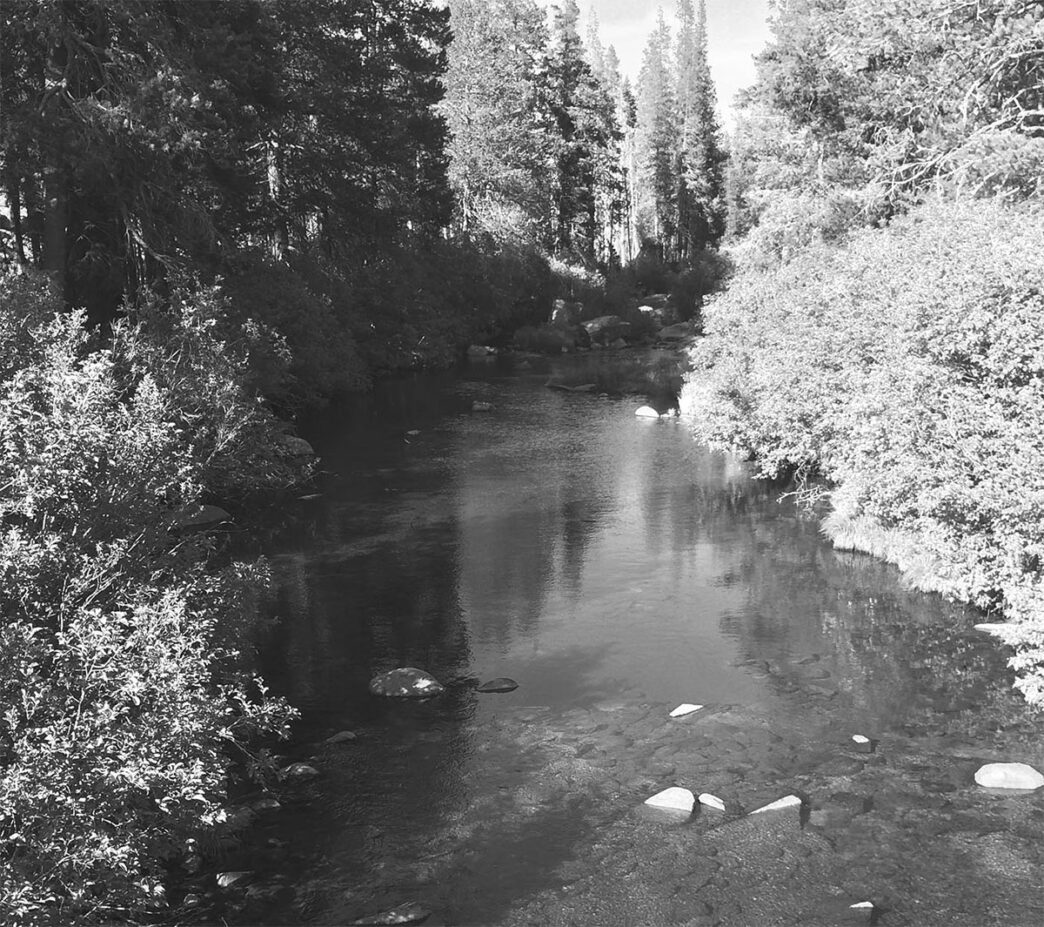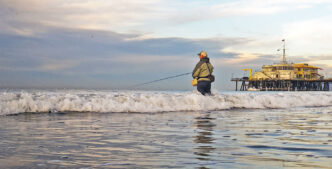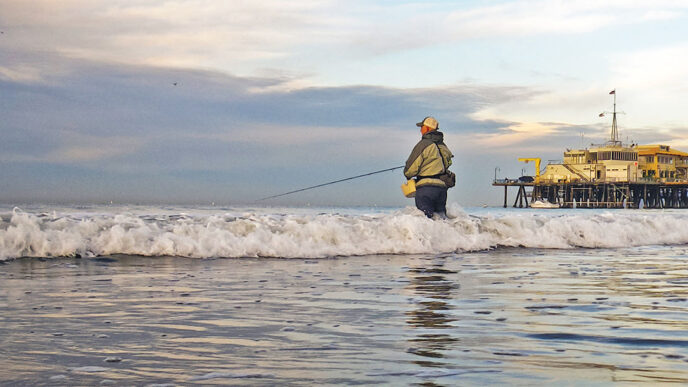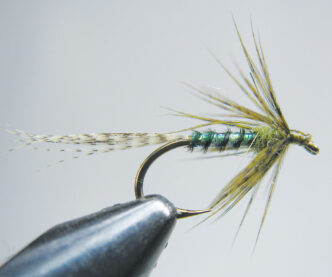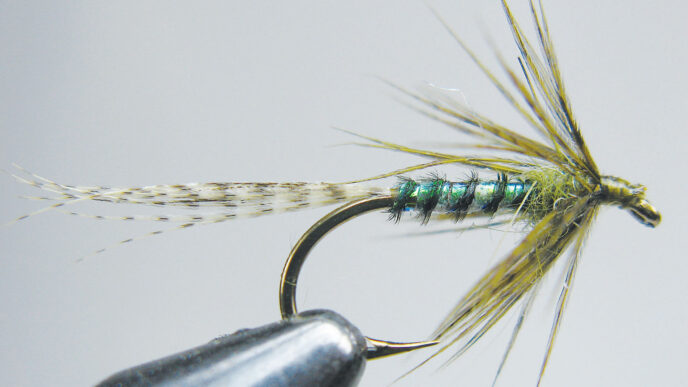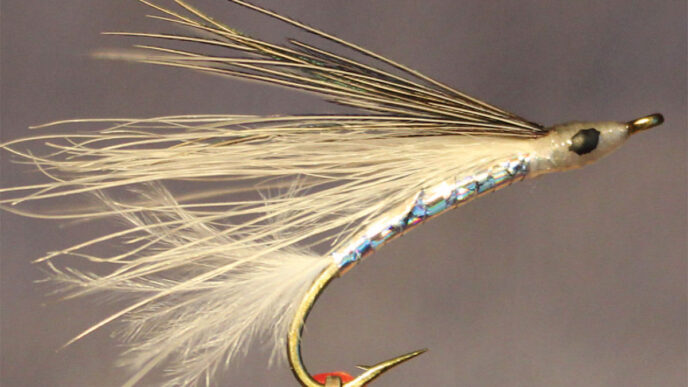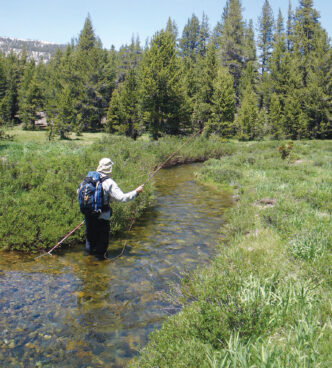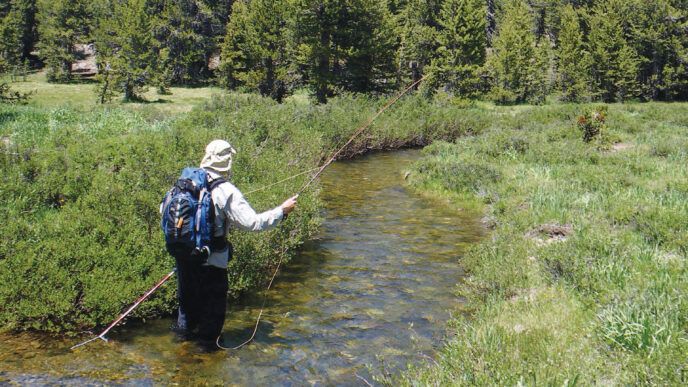I’m guessing that most of us who fish for trout have more 8-1/2-foot and 9-foot rods in our closets than rods of every other length. That’s partly because most of us fish graphite rods, and graphite’s light weight makes long rods for trout-weight lines possible. Long rods also seem to be a sensible choice on the larger waters that are popular in California. And of course, they’re the accepted fashion.
T’weren’t always so, though.
In the 1960s and early 1970s, before graphite became the dominant rod-building material, an 8-1/2-foot or 9-foot rod was pretty much reserved for salmon, steelhead, or saltwater fishing. Long glass and bamboo rods — which I’ll arbitrarily classify as anything over 8 feet — for line weights as light as 5 were available, but they were not the norm and were generally bought by sophisticated anglers who wanted something special for special waters. They were also likely to be the product of an artisan rod shop such as Winston or Powell and were priced higher than production rods. For the rest of us, while an 8-1/2-foot 7-weight or 8-weight, or a 9-foot 9-weight or 10-weight might have been part of our kit, our trout rods for line weights 6 and less would likely have been shorter: 7-1/2 or 8 feet, depending on where we fished.
Back in the 1960s, if you read magazine articles and fishing books and kept up with the experts, you might have gone looking for an even shorter rod. The folks writing about fly fishing back then would have been, for the most part, guys with roots in the fly-fishing traditions of Catskill rivers in New York or the Poconos in Pennsylvania: Art Flick and Lee Wulff for the former, for example, or Charles Fox and Vince Marinaro for the latter. Their influence on American fly fishing, most of it positive, can’t be underestimated. Gentlemanly, civilized practitioners of the dry fly who fished rivers that were smaller and more tranquil than many Western waters, these guys were for years the national arbiters of fly-fishing tackle. They liked short rods, and since their ideas were frequently published, that is what we read about.
Lee Wulff, who Esquire editor Arnold Gingrich described as “the fly rod’s most versatile exponent,” fished for salmon with a 6-foot rod, so what wasn’t to like about a short rod for mere trout? Except for some “midge” rods by Orvis or Michigan’s Paul Young or San Francisco’s R. L. Winston, most of these rods handled an HCH-graded silk line, equivalent to today’s 6weight or sometimes 7-weight lines. By today’s standards, a 6-weight line is streamer tackle and anything but light. But “lightness” and “sporting” back then were generally equated with length, so the guy who fished a little 7-footer with a 6weight line felt he was challenging himself and the trout more seriously than someone fishing an 8-footer or and 8-1/2-footer. In a way, I suppose, he was, since his heavier line landed less stealthily, and his short rod gave the fish a bit of an advantage with the light tippets that back then were about half the strength of what we have today. But hey, it was the current fashion and the sporting way. I remember being really disappointed that the fine Powell bamboo rod that my father occasionally allowed me to fish was a 9-footer, instead of the 7-foot and 7-1/2-foot rods after which I lusted.
Of course, that short-rod movement was itself a reaction to the longer, heavier bamboo rods commonly fished until the early 1950s, when fiberglass began to take over. Although some of those bamboo sticks were terrific, most of them were anything but lightweights. A Wright and McGill Favorite, Heddon Black Beauty, or South Bend 357, equivalents of good midpriced rods available today, would have weighed 5 ounces or so, even at 8-1/2 feet. Except for hollow-built Winstons and Powells, whose following was largely on the West Coast, top-shelf bamboo rods in 8-1/2-to-9-foot lengths — Leonards, Orvises, Youngs, Thomases, and Paynes, for example — would frequently go over 5 ounces, particularly in easy-to-transport three-piece versions.
Early fiberglass rods weren’t much lighter than bamboo, and by the 1960s, the short-rod movement had connected with that material, too. Some short glass rods by specialty builders such as New York’s Vince Cummings and California’s Russ Peak were exceptionally nice, and Fenwick’s 6-foot 5-weight F60 now sells on eBay for multiples of its original price. But when graphite came on the scene in the mid-1970s, it did so with a vengeance and changed the game again. Long rods for lightweight lines, rods that weighed 3 ounces or less, were now possible, and it didn’t take long before the 9-foot graphite rod for 4-weight or 5-weight lines was what everyone fished, or at least saved up to buy. I recall an Outdoor Life magazine cover from 1975 or 1976 that showed Lefty Kreh breaking a bunch of short rods over his knee.
The graphite revolution notwithstanding, it’s still a fact that short rods made good sense to some pretty critical folks for quite a while. Learn something like Lee Wulff ’s constant-pressure, full-arm casting stroke, and you could punch outline to 70 feet with a short stick. You could also generate pretty high line speeds and cast “under the wind.” Because the rod was relatively light, it wasn’t that difficult to hold it high to keep drag at bay, and the short length made it easy to bring a fish to hand or net. If you’d fished heavier long rods before, the short stick was an exciting new opportunity. And it was fun — though it’s hard for me to think of anything associated with fly fishing for trout that isn’t fun.
So just for the hell of it, let’s assume that having fun is what we’re seeking when we’re fishing, as opposed to some ideal technical solution to an angling challenge. If acknowledged experts back in the day were sold on short rods, is there something to them that we’re missing today?
Back in the 1980s, when I was heavily invested in long graphite rods, I recall one experienced Montana fly shop owner, a guy who sold a lot of 9-foot 4-weights, telling me that he preferred 7-1/2-foot and 8-foot rods on spring creeks because he could strike fish faster than with a longer rod. Another friend who spends his summers on the Henrys Fork likes to cast small nymphs without an indicator to sighted fish. A slow, quiet stalk and a 15-to-20-foot cast are his meat and drink. He fishes glass rods most of the time, and an 8-foot rod is his choice. Still another friend told me that he recently fished a 7foot fiberglass 3-weight on Hat Creek, and while he was limiting himself a bit by not being able to manipulate line as well as with a longer rod, the suppleness of fiberglass, combined with the light line, made up for it in grins when he hooked a fish. And then there’s the guy who fishes a 71/2-foot graphite 4-weight from his pram on still waters. Since he can stand to cast, lack of length is less a factor than were he wading, and he does as well as the guys with longer rods fishing from tubes and pontoon boats.
Even if a short rod limits you somewhat in how far you can cast and in how much line you can control during a drift, for much trout fishing those aren’t significant drawbacks. Tiny streams are no problem, of course, since you’re rarely casting more than 25 feet. Harry Murray, of Edinburg, Virginia, the dean of fly fishers in Shenandoah National Park, promotes and fishes little 4-weight 7-foot graphite rods that he has a major rod company build for his shop. He convinced me of their usefulness — and fun — when I fished with him, and a rod of that configuration has been my choice for years for our little Sierra creeks.
What you can’t do as well with a short rod is fish-heavy nymphs with added weight under larger indicators. The long lever of a longer rod makes those things possible. Still, it’s surprising how well a short rod fishes a small indicator — or a hopper above a nymph in the size-14-to18 range . . .imitations that represent a lot of what trout eat. You just cast more off the butt of the rod and lengthen your casting stroke a bit. I still get excited watching a six-inch brookie take a Humpy that’s almost as big as his mouth. Or her mouth, for that matter. And it’s even better when you lift up your little rod and feel the weight of a big trout moving off.
You’ll find a lot of choices for short rods under 7-1/2 feet from rod makers who are working in glass and bamboo, but fewer from graphite manufacturers. Most graphite rod lineups tend to start at 7 feet 6 inches and go up from there, but a few makers offer shorter rods. Orvis’s Helios 2 Superfine Touch and Access series have a handful of rods 7 feet and under. TFO’s Lefty Kreh Finesse series go from 5 feet to 7 feet 3 inches. Hardy offers Flyweight and Featherweight rods at 6 and 7 feet, and Echo has a couple of short rods in the Solo and Carbon series.
Regardless of the material, most contemporary short rods for freshwater fishing are built to handle light fly lines: 3-weights and 4 weights, for the most part, though occasionally there are offerings as light as 1-weight or as heavy as 5-weight. That’s a significant change from the 1960s, when a 5-weight line was about as light as you could go without going to a specialty maker. The change owes in part to modern line-fabrication technology, which makes light lines as easy to produce as heavier ones, and in part to angler acceptance of the fact that lightweight lines are serious fishing tools. Very few 3-weight or 4-weight lines were available even as late as the mid-1970s, and those were seen by many as toys for tiny flies and small fish. Today, there are scores of good 3-weight and 4-weight lines available, and we equate them more with delicacy of presentation than with fringe tackle for the effect.
When fishing alone from a small watercraft, a short rod can be easier to handle than a longer one. That makes them handy for some other species of fish than trout: largemouth bass, for instance, particularly from a canoe or kayak. There aren’t many 7-foot or 7-1/2-foot fly rods built for line weights that will handle bass-size flies and poppers, but an 8-foot rod for a 7-weight or 8-weight line rod will, and that’s another combination that’s currently out of fashion. It will also have the muscle to snub a fish before it wraps your tippet up in the brush. TFO’s Mini Mag and Sage’s Bass II series at 8 feet and 7 feet 11 inches, respectively, for lines in the 200-to-400-grain range (think 7-weight to 12-weight), are well suited for small boats and close-quarters slugfests. They’re also just the ticket if you find yourself fishing for snook or baby tarpon in a backcountry mangrove tunnel. And Sea Level Fly Fishing’s Extreme Inshore Series, at 7 feet 11 inches for line weights 7 through 10 is designed specifically for salt water and fitted with assist grips ahead of the handle.
Those sticks are a long way from being trout rods, of course, but the idea is still the same: short rods can be effective, even if they don’t represent the current fashion, just as long rods proved effective when the fashion was to go short. In this case, it’s just another way of saying that going backward can sometimes open up interesting new territory.
Next time around, new products for 2014 from the International Fly Tackle Dealer Show.



